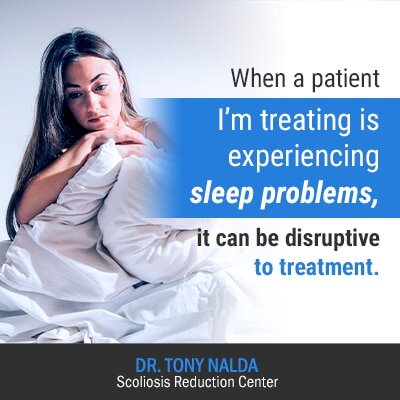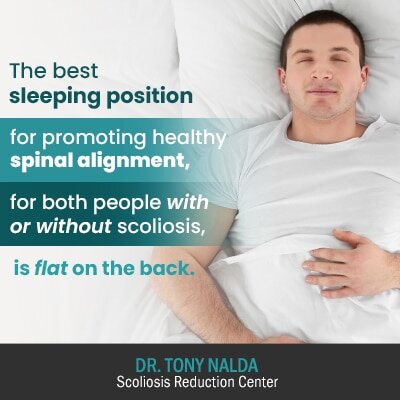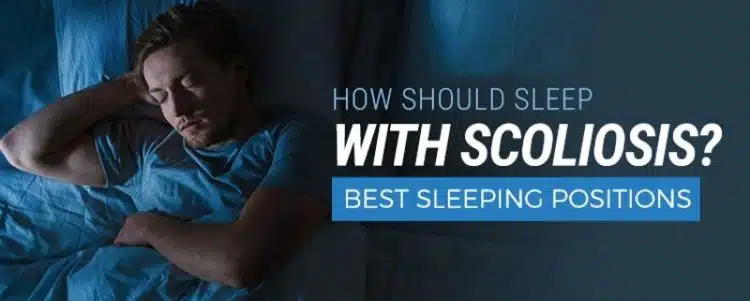For those living with scoliosis, this means their spine is abnormally bent to the side and rotates. More so for adults, scoliosis can be a painful condition, and when it comes to knowing the best sleeping position, it’s all about promoting healthy spinal alignment and not introducing additional stress to the spine.
Before we discuss the particulars regarding good and bad sleeping positions for scoliosis, let’s first consider why sleep is particularly important for a person facing the rigors of a spinal disorder.
4 Key Takeaways
- Importance of Sleep for Scoliosis Management: Quality sleep is crucial for the overall wellbeing and treatment efficacy for individuals living with scoliosis. Adequate rest supports physical and mental health, enhancing the body’s ability to cope with and recover from the condition’s challenges.
- Best Sleeping Positions for Scoliosis: Sleeping on the back or side is recommended for individuals with scoliosis to promote healthy spinal alignment. These positions help distribute weight evenly and support the spine’s natural curves, reducing stress and discomfort.
- The Worst Sleeping Position: Stomach sleeping is considered the least beneficial for people with scoliosis, as it can exacerbate spinal misalignment and discomfort by unnaturally arching the back and straining the neck.
- Customized Support and Alignment: Utilizing a customized pillow designed to match one’s body size and type can significantly enhance sleep quality by properly supporting the cervical spine and maintaining spinal alignment, further contributing to scoliosis management.
Sleep and Treatment Efficacy
We have all experienced the challenges of facing daily responsibilities after a bad night’s sleep.
While most people don’t have a perfect sleep every night, over time, sleep issues that are left unaddressed can lead to multiple problems. As chronic sleep deprivation presents as depression, we know how important rest is for both the body and the mind.
When it comes to treating people here at the Scoliosis Reduction Center®, I’ve seen the difference, firsthand, between treating a patient with or without sleep problems, and it is a substantial one.
Just consider for a moment how productive you are on an average day. Think of all the things you might have to do on a daily basis: go to work, clean, look after children, drive here and there, etc.
Imagine having to do all those things on very little sleep, and then imagine the cumulative effect of living life like that. Then imagine having a spinal deformity, such as scoliosis, also factoring in.
If you are an adult living with scoliosis, it’s likely you will be experiencing some pain and discomfort as a result of spinal compression. This can make it that much harder to find an ideal sleeping position.

Not to say that adolescents with the condition wouldn’t struggle with any scoliosis-related back or muscle pain, but in general, scoliosis is not painful for adolescents; this is because as their spines are still growing, they are not vulnerable to the compressive force of the curvature.
When a patient I’m treating is experiencing sleep problems, it can be disruptive to treatment. We know there is a strong connection between treatment success and treatment started early on in the condition’s progressive line.
Once we start active treatment, we don’t want to pause it or stop because a patient doesn’t have the energy due to sleep troubles.
Mindset is also hugely important when it comes to treatment success and having the mental strength and dedication needed to commit to and follow through with a treatment plan; sleep is a great regulator of emotion and mental resilience.
If a patient is struggling with energy levels due to a lack of sleep, we address it as we would any other scoliosis symptom: proactively. I would spend time discussing my patient’s sleep habits, including how to encourage healthy spinal alignment through sleep position, and measuring them for a customized pillow.
The Best Sleeping Positions for People with Scoliosis
Sleep position plays a role in promoting spinal alignment for an average person; for a person with scoliosis, this is especially important.
When a person has scoliosis, their spine rotates and is no longer aligned the way it should be. A healthy spine has three main natural curves, and these curves give the spine its strength, flexibility, and allow us to stay upright and maintain good posture.
For a person with scoliosis, they have lost one or more of these healthy curves, and as a result, the overall biomechanics of the spine are disrupted; this is why people with scoliosis can experience postural and overall asymmetrical changes to the body.
While no two people will experience scoliosis exactly the same as the condition ranges from mild to moderate, and severe, some people describe their scoliosis-related discomfort as feeling weighed down or the feeling of being stretched. These extra challenges make it that much harder to find the ideal sleeping position.
Following are the best sleeping positions for people with scoliosis, and as they are all about promoting a healthy spinal alignment, these sleeping positions are also the best for people without scoliosis.

Back Sleeping
The best sleeping position for promoting healthy spinal alignment, for both people with or without scoliosis, is flat on the back.
This position supports the natural healthy curves of the spine: cervical curve (upper back) and the lumbar lordosis (lower back’s inward curve).
Sleeping flat on the back evenly distributes a person’s weight across the body so there is no additional stress or tension placed on the spine.
Side Sleeping
After sleeping flat on the back, the next best sleeping position for scoliosis is sleeping on the side with a pillow that adequately supports the head in a healthy and neutral alignment with the torso, which then keeps the torso in alignment with the pelvis.
In addition, placing a thin pillow between the knees while sleeping on the side can also help keep the spine optimally aligned and supported during sleep.
When explaining the concept of spinal alignment, I often refer to the image of a snowman. If you think of a classic snowman with three snowballs, how they each need to be as centered and balanced as possible to prevent slippage is the type of spinal alignment you want to strive for: the head is neutral and centered over the torso while the torso is centered over the pelvis.
Regardless of position, a person with scoliosis will still have the rotation and misalignment present, but to return to the snowman image, even if there is a curvature between the snowballs, good positioning can help keep them as aligned as possible.
Now that we have discussed the best sleeping positions for scoliosis and why, let’s look at what the worst sleeping position is.
Bad Sleeping Positions for Scoliosis
When it comes to bad sleeping positions for scoliosis, and anyone else for that matter, sleeping on the stomach is the worst. In addition to sleeping position, for someone with scoliosis, an appropriate pillow can also be beneficial.
Stomach Sleeping
For a person living with scoliosis, stomach sleeping is the worst sleeping position because it does not adequately support the spine or promote healthy spinal alignment.
When a person lies flat on their stomach, the back is unnaturally arched, and this is an unhealthy position for the upper back and neck.
Sleeping on your stomach arches the back, putting the upper back and neck in an unnatural position; this puts extra stress on the spine. For someone with scoliosis whose spine is already experiencing adverse spinal tension, this can increase discomfort and further disrupt sleep.
Customized Scoliosis Pillows
Something people often overlook is the benefit of a properly-fitted pillow.
Just as the nature of scoliosis, and how it varies from one person to the next, necessitates a customized treatment approach, a customized pillow can also help promote optimal sleep.
The problem with average pillows is that they are one size fits all, and clearly, a person who is 6-feet tall is going to need a different pillow size than someone who is 5-feet tall.
The idea behind getting a customized pillow is that it is fitted to your body type, size, shoulders, back, and pelvis.
With a pillow that is customized to suit your body, the upper spine and neck (cervical spine) is adequately supported and aligned with the rest of the body, and this promotes healthy spinal alignment.
Conclusion
When it comes to the question of how you should sleep with scoliosis, it’s all about keeping the spine in a neutral position that promotes a healthy alignment and adequately supports it.
For a person living with scoliosis, they have extra emotional stress and physical demands placed on their bodies. Being able to strike a balance with work, play, rest, and treatment can be a challenge.
While sleep position might seem like a minor thing, when considering a spinal condition marked by postural changes and a wide range of symptoms, anything that affects a person’s ability to sleep and recharge is anything but.
Sleeping on the back is the best position, followed by side sleeping; these positions are good because they support the spine, don’t put it in an unnatural position, and promote a healthy spinal alignment.
When it comes to bad sleeping positions for scoliosis, that would include sleeping on the stomach, unnaturally arching the upper back, and using a pillow that doesn’t suit an individual’s body type and/or size.
The important thing to remember is that no sleep position, good or bad, has the power to induce a structural change to the spine. Some people think if they sleep in a position that counteracts their unnatural curvature, this can help reposition the spine; this is not the case.
The only way to address the structural nature of scoliosis is to treat it proactively with a functional approach that combines multiple treatment disciplines. When this is done successfully, we can reduce a patient’s abnormal curvature on a structural level and work towards supporting and stabilizing the spine in a healthy position.





